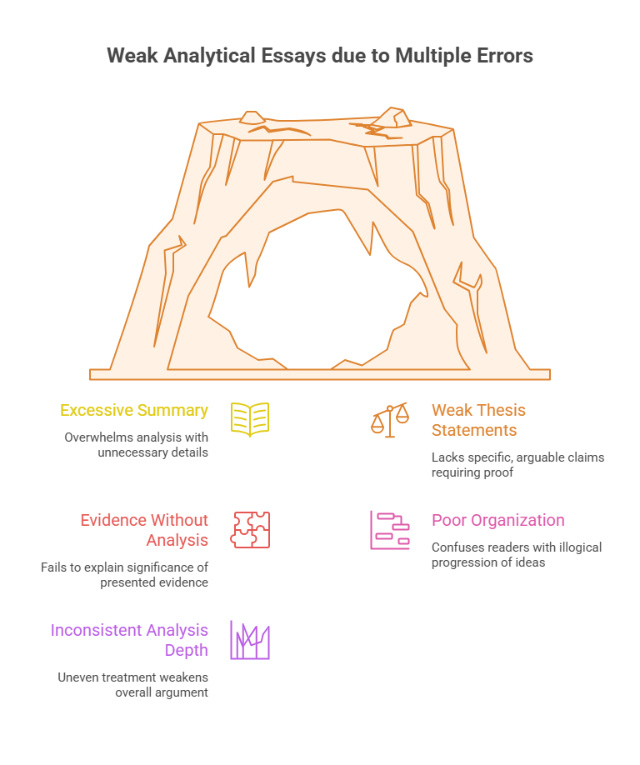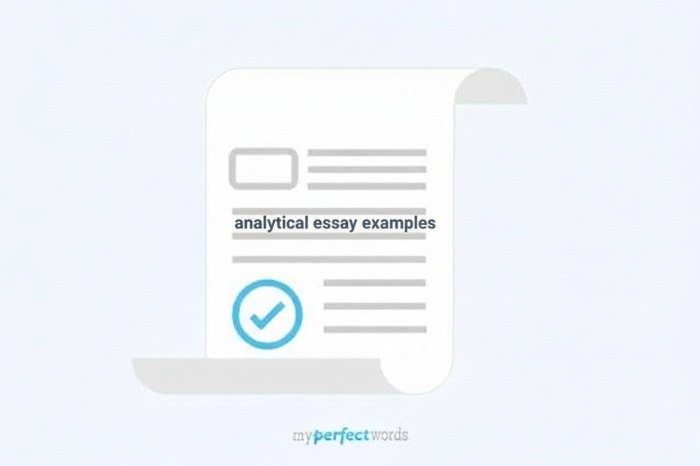You've got an analytical essay due, and you're staring at a blank page, wondering where to start. Maybe the deadline's tomorrow. Maybe you've read the assignment three times and still don't get what your professor wants. Either way, you're not alone, and you're in the right place.
This guide breaks down exactly what an analytical essay is, how to write one step-by-step, and the mistakes that tank most people's grades. By the end, you'll know how to structure your analysis, develop a thesis that actually says something, and connect evidence to arguments. Or you'll know when it's time to get help.
Short on time? Our analytical essay writing service handles everything research, writing, revisions. You just review and submit.
What Is an Analytical Essay?
An analytical essay breaks down a topic, whether it's a book, film, event, or idea, and examines how its parts work together to create meaning. This analytical essay definition distinguishes it from other writing types: unlike a summary (which just retells what happened), analysis explains WHY and HOW something works.
The analytical essay's meaning goes beyond description. Think of analytical writing as detective work; you're not just reporting what you see, but interpreting what it reveals.
Here's the difference:
Summary: "The book is about a man who chases a dream."
Analysis: "Fitzgerald uses Gatsby's obsessive pursuit of wealth to critique the American Dream, showing how materialism corrupts authentic human connection."
See? The summary describes. Analysis interprets and explains significance.
The key characteristics of analytical writing include:
- A clear thesis: Your argument about what the analysis reveals
- Evidence from the source: Quotes, examples, data that support your claim
- Your analysis: The explanation of what that evidence means and why it matters
- Critical thinking: Moving beyond obvious observations to deeper insights
The key distinction: you're not just saying WHAT something is. You're explaining HOW it works and WHY it matters.
Types of Analytical Essays
Analytical essays come in several forms. Here's where to learn about each:
Literary Analysis: Analyzes literature, themes, and symbolism.
Rhetorical Analysis: Examines persuasive techniques in speeches, ads, or texts.
Character Analysis: Studies how characters develop and what they represent.
Process Analysis: Explains how something works step by step.
Visual Analysis: Examines images, art, or visual media.
Each type uses the same core analytical skills but applies them to different subjects.
Deadline Breathing Down Your Neck?
Our writers deliver polished analytical essays—researched, structured, and ready to submit.
- 24/7 Analytical Essay Help
- 100% human-written
- Delivered on time, every time
- Unlimited revisions
Your information stays secure while we deliver outstanding analytical essays.
Order NowHow to Write an Analytical Essay (Step-by-Step)
Whether you're learning how to write an analytical essay for the first time or how to write an analysis paper for a college course, the process remains the same. Here's how to break it down into manageable steps.
Step 1: Understand Your Assignment
Before you write anything, know what's being asked:
- What are you analyzing? (Text, process, event, concept?)
- What's the analytical focus? (Themes, techniques, causes, effects?)
- What's the required length and format?
- What sources can you use?
If the prompt says "analyze," you need to break something down and explain how it works. If you're unclear on any of these questions, ask your instructor before starting.
Step 2: Choose Your Angle
You can't analyze everything about a subject in one essay. Pick a specific angle that's interesting and arguable.
Weak angle: "Hamlet is about revenge."
Strong angle: "Hamlet's delay stems from philosophical contemplation rather than cowardice."
Good analytical angles have room for interpretation. They're not obvious facts everyone agrees on. They require evidence and explanation.
Need inspiration? Check our analytical essay topics for 240+ ideas organized by category.
Step 3: Gather Evidence
Once you know your angle, collect evidence that supports it. Evidence types vary:
- Literary analysis: Quotes from the text, specific scenes, character actions
- Rhetorical analysis: Examples of persuasive techniques, audience reactions
- Process analysis: Steps in the process, observable details
- Causal analysis: Data, documented events, expert testimony
Gather more evidence than you'll use. Having options lets you choose the strongest examples. Annotate as you go, mark significant passages, and jot down initial thoughts about what they mean.
Step 4: Develop Your Thesis
Your thesis is your main argument, the claim your entire essay will prove. It should be:
Specific: Not "Shakespeare uses imagery" but "Shakespeare's blood imagery represents guilt's inescapability."
Arguable: Someone could reasonably disagree, and you'd need to prove your point
Analytical: Goes beyond obvious observation to make an interpretive claim
Formula for analytical thesis:
[Author/Subject] uses [technique/element] to [reveal/demonstrate/critique] [insight about meaning/significance].
Weak Thesis: "The Great Gatsby has themes about wealth."
Strong Thesis: "Fitzgerald uses Gatsby's downfall to critique the American Dream, showing how the pursuit of wealth corrupts authentic connection."
Step 5: Organize Your Data
Before you draft, map out your argument. A solid outline prevents organizational disasters later.
Analytical essays follow standard academic organization: introduction, presenting your thesis, body paragraphs developing analysis with evidence, and conclusion synthesizing insights. This structure helps readers follow your reasoning and understand how individual points support larger arguments.
Your introduction establishes context and presents your analytical thesis. Body paragraphs each focus on one supporting point, presenting evidence and explaining its significance. Your conclusion connects the analysis back to the thesis, exploring implications rather than merely restating points.
This basic framework applies across analytical types literary analysis, rhetorical analysis, process analysis, or comparative analysis. What changes is the content and evidence type, not fundamental organizational principles.
Want a copy-paste template you can fill in? Grab our analytical essay outline with brackets for your content.
Step 6: Write Your First Draft
Don't aim for perfection; get your ideas down. You'll revise later.
Key principles:
Lead with analysis, not summary. Assume your reader knows the basic plot or facts. They need YOUR interpretation.
Use the PEEL method for body paragraphs:
- Point: Topic sentence stating your claim
- Evidence: Quote, example, or data
- Explain: Analysis of what the evidence means
- Link: Connection back to your thesis
Watch your ratio: For every sentence of evidence, write 2-3 sentences of analysis. If you're quoting more than you're analyzing, you're summarizing, not analyzing.
Step 7: Revise for Stronger Analysis
First drafts always need work. Set yours aside for a day, then come back with fresh eyes.
Ask yourself:
- Does every paragraph support my thesis?
- Have I explained WHAT the evidence means (not just presented it)?
- Have I explained WHY it matters?
- Are there any "so what?" moments where I state facts without interpreting them?
- Does my analysis go beyond the obvious?
Common weak spots:
- Dropped quotes: Evidence appears without introduction or explanation
- Plot summary: Retelling what happens instead of analyzing what it means
- Vague analysis: "This shows Gatsby is sad" vs. "This imagery suggests Gatsby's wealth has failed to fill the emotional void left by Daisy's absence."
Revision is where good essays become great. Don't skip it.
Still Staring at a Blank Page?
Our writers deliver polished analytical essays—researched, structured, and ready to submit.
- Expert Writers Standing By
- 100% human-written
- Delivered on time, every time
- Unlimited revisions
4.8 rating from 144,000+ completed orders.
Get Started NowOpening Strategies That Work
Surprising fact or statistic: "Despite spending $150 billion annually on advertising, 86% of viewers skip commercials yet Super Bowl ads still command $7 million for 30 seconds."
Thought-provoking question: "Why does Hamlet, consumed by revenge, spend four acts avoiding it?"
Relevant quote: "'So we beat on, boats against the current' Fitzgerald's final line captures Gatsby's central tragedy."
Vivid context: "In 1925, America was drunk on prosperity and promise. Fitzgerald's Gatsby exposed the hangover."
Choose the hook that best fits your subject and angle. Then provide 2-3 sentences of context and end with your thesis.
What to Include in Your Intro
Your introduction needs three elements:
- Hook (1-2 sentences): Grab attention
- Context (2-3 sentences): Background reader needs
- Thesis (1 sentence): Your analytical claim
What NOT to do: Start with "In this essay, I will..." or dictionary definitions. Get to your argument quickly.
See how strong intros work in practice? Check out our analytical essay examples to see what works.
Organizing Your Analysis
Every analytical essay follows the same basic structure. Understanding what analytical writing is starts with understanding how to organize your ideas effectively. Here's what each part does.
Introduction
Introductions accomplish several goals: capturing the reader's interest, providing the necessary context, and presenting your thesis. Move from general background to your specific analytical claim, narrowing focus as you progress.
Begin with engaging hooks, relevant questions, surprising facts, or thought-provoking statements that connect to your analysis. Provide a brief context that readers need to understand your subject and approach. Present your thesis clearly, typically as your introduction's final sentence.
Strong introductions are typically 8-10% of the total essay length. They establish analytical direction without overwhelming readers with excessive detail before analysis begins.
For complete introduction examples with annotations showing effective techniques, see our analytical essay examples page, which includes sample introduction paragraphs across different analytical types.
Body Paragraphs
Body paragraphs form your analysis's core. Each develops one focused point supporting your thesis through evidence and interpretation. Structure them consistently using topic sentences, evidence presentation, thorough analysis, and logical transitions.
To see this structure in action with annotated examples highlighting each component, visit our analytical essay examples collection.
Conclusion
Conclusions accomplish more than repeating introductions. Effective conclusions synthesize analysis, exploring implications and significance rather than merely restating points already made. Conclusions typically comprise 8-10% of total essay length.
For fill-in-the-blank paragraph templates you can adapt to your own analysis, check our outline guide.

How to Write a Conclusion for an Analytical Essay
Your conclusion does more than summarize. It should leave readers with a clear understanding of why your analysis matters.
The Three-Part Formula
1. Restate your thesis (1 sentence)
Don't copy your introduction. Rephrase your argument, emphasizing the conclusions your analysis reached.
Original thesis: "Fitzgerald uses Gatsby's downfall to critique the American Dream."
Conclusion restatement: "Through Gatsby's tragic pursuit of wealth and status, Fitzgerald exposes the American Dream as a corrupting force that destroys authentic connection."
2. Synthesize your main points (2-3 sentences)
Briefly recap the key insights from your analysis. Show how they work together to prove your thesis.
"The green light symbolizing unreachable desire, the contrast between West and East Egg revealing insurmountable class barriers, and Daisy's 'voice full of money' equating human worth with wealth, each element builds Fitzgerald's critique."
3. Explore broader significance (1-2 sentences)
Answer the "so what?" Why should readers care about your analysis? What implications does it have?
"A century after Gatsby's publication, Americans still chase the same illusion, believing the right house, car, or income will finally deliver belonging. Fitzgerald suggests this pursuit doesn't just fail; it prevents us from recognizing the connections we already have."
Still stuck? Get analytical essay help from our experts, thesis, structure, analysis, all of it handled for you.
Bottom Line
An analytical essay is your chance to show you can think critically about a topic, not just summarize it. Focus on your thesis, support it with evidence, and always explain the "so what."
The key is moving beyond observation to interpretation. Don't just tell readers what the text says or what happened. Explain what it means, why it matters, and what it reveals about your subject.
Whether you write it yourself or get help, the goal is the same: turn in something you're proud of. And do you need backup? We're here.
GET YOUR ESSAY DONE
Our writers deliver polished analytical essays—researched, structured, and ready to submit.
- 100% human-written
- Delivered on time, every time
- Unlimited revisions
- Private & Confidential
Free revisions until you're 100% satisfied.
Order Now



